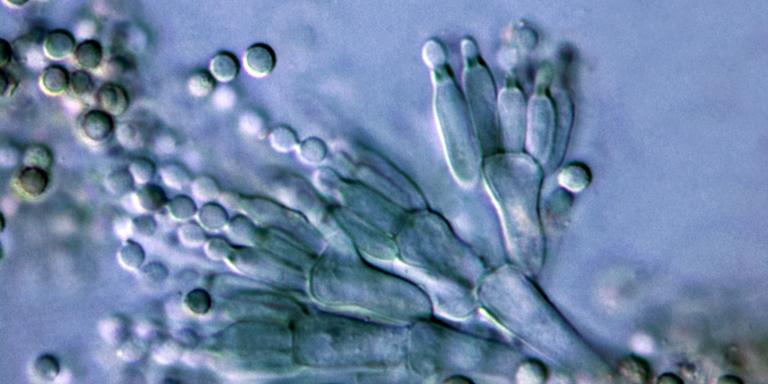Mould allergy
Moulds are found all over the world, and proliferate particularly in damp environments, both outdoors and indoors.

Table of contents:
Increased exposure to mould can have a number of consequences for human health. In sensitive individuals, respiratory allergies can develop or worsen.
Triggers
The main moulds known to trigger allergies include Alternaria alternata, Aspergillus fumigatus, Cladosporium herbarum and Penicillium chrysogenum.
Alternaria alternata spores are found in varying quantities in outdoor air, depending on the season, climatic conditions, vegetation and human activities. The highest concentrations are generally measured in summer and autumn in rural areas near cereal crops, pastures and meadows. The release of spores is particularly high during periods of good weather alternating with rain, as well as during harvesting and haymaking. Cladosporium herbarum, although less important from an allergological point of view, is also one of the triggers present in outdoor air.
In indoor spaces, the most common triggers are Aspergillus and Penicillium. These moulds thrive regardless of the season in damp places such as poorly insulated walls, unmaintained air-conditioning systems, humidifiers and poorly ventilated bathrooms and kitchens. The presence of decorative fountains, aquariums or lots of green plants can also contribute to high air humidity, encouraging mould growth.
Symptoms
In addition to irritation of the mucous membranes of the eyes, nose and throat, allergic reactions are among the main consequences of increased exposure to mould. The symptoms are typical of respiratory allergies: allergic rhinitis, watery eyes, coughing and respiratory problems (asthma) are common. Non-specific symptoms such as headaches or sleep disturbances may also occur.
Diagnosis
The diagnosis of a mould allergy is based first and foremost on an exhaustive history, accompanied by a clinical examination. Skin and blood tests can then be carried out to identify precisely the allergen(s) responsible for the symptoms.
Good to know: diagnosing a mould allergy is generally complex. On the one hand, the symptoms may be confused with those of other, more common allergies, such as to pollen, dust mites or animal hair. Secondly, because of the limited number of extracts available for skin and blood tests and their variable quality, a mould allergy cannot be ruled out with certainty based on negative results.
Treatment
Depending on the allergen responsible and the severity of the symptoms, there are several pillars to the treatment of a mould allergy.
The most effective measure is always to limit contact with the allergens.
Mould spores in outdoor air are dispersed mainly in summer and autumn, when dry, windy weather alternates with rainy spells. It may therefore be wise for those affected to avoid walking in forests or near cereal fields during these periods. Collecting dead leaves or spreading compost are also activities to be avoided.
In the event of symptoms linked to the presence of mould indoors, a complete remediation must be carried out quickly and in accordance with the rules of the trade.
According to current scientific knowledge, there is no reliable measurement method for detecting the presence of hidden mould or for assessing the health risks associated with its presence.
Problems of dampness, visible mould or musty odours should be reported to building owners or managers. They are then responsible for identifying and eliminating the causes of the excess damp. Where the extent of the damage is unclear or the cause remains unexplained, a building physics specialist should be contacted.
Once the cause has been identified and removed, the affected areas should be remediated. Warning: people with allergies, asthma or a weakened immune system are strongly advised not to carry out the work themselves. If you have health problems, or if the extent of the mould is significant, we recommend that you contact the appropriate specialists.
Good to know: damp and mould problems should be identified and eliminated even if there are no visible consequences for the health of those exposed.
As with other respiratory allergies, medication such as antihistamines or cortisone-based preparations can provide temporary relief. In the case of asthma, sprays to dilate the bronchial tubes and treat inflammation are generally prescribed.
More information about the treatment of respiratory allergies
When the trigger or triggers responsible for the symptoms have been precisely identified, which is rarely the case, and the measures put in place and medicinal treatment are not sufficient, specific immunotherapy (desensitisation) may be considered. However, the effectiveness of this treatment has only been demonstrated for Alternaria alternata, a mould found mainly in outdoor air.
Tips and tricks
A number of relatively simple measures can be taken to limit the risk of mould in indoor spaces. For example:
- Maintain a relative humidity of between 30 and 50 per cent – 40 per cent maximum in winter – and a temperature of around 20°C.
- Limit unnecessary humidity. For example, avoid drying clothes in living areas, avoid using humidifiers, choose a covered aquarium and reduce the number of green plants.
- Ventilate rooms thoroughly for five to ten minutes two or three times a day.
- Leave enough space (approx. 10 cm) between furniture and outside walls
- Empty compost bins regularly and take out rubbish bags promptly
The FOPH's ‘Mould in living accomodation’ brochure provides a wealth of useful information on what to do in the event of mould proliferation in indoor spaces.
Facts and figures
According to the FOPH, one in four or five Swiss households is affected by damp and mould problems.
The prevalence of mould awareness is currently not known precisely. In Switzerland, it is estimated that between one and ten per cent of the population is affected. The prevalence is higher among asthma sufferers than in the population as a whole.
Editors: aha! Swiss Allergy Centre in co-operation with the Scientific Advisory Board.




